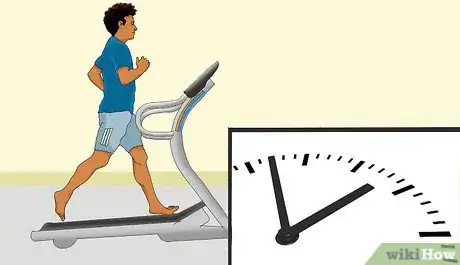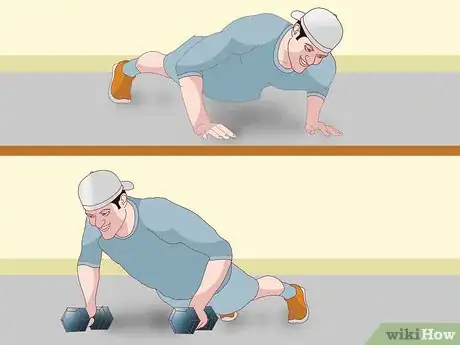This article was co-authored by Scott Anderson, MA, ATC, SFMA, DNSP. Scott Anderson is the Chief Clinical Officer at SyncThink, an award winning startup founded out of Stanford University. Scott previously served as the Director of Sports Medicine/Athletic Training for Stanford University for over ten years from 2007 to 2017. Scott has over 18 years of clinical and management experience, and is a recognized international speaker on topics of clinical specialization, which include developmental kinesiology, neuroscience/concussion, and movement dysfunction. He is a certified Dynamic Neuromuscular Stabilization Practitioner (DNSP), Sports Safety Specialist and is certified to conduct Selective Functional Movement Assessments (SFMA), and Functional Movement Screenings (FMS). He earned a BS in Athletic Training from Washington State University in 2000 and an MA in Athletic Administration from Saint Mary's College in 2002.
There are 17 references cited in this article, which can be found at the bottom of the page.
This article has been viewed 109,989 times.
Interval training (sometimes called high-intensity interval training, or HIIT) involves alternating between periods (or intervals) of high-intensity exercise (like sprinting) with low-intensity exercise (like walking). By increasing your heart rate and the number of calories burned over a brief period of time and then reducing your cardio workout's intensity back to your normal conditioning level, you will drastically improve your overall aerobic performance levels.[1] Any type of cardio workout can be used in interval training, but it's important to know your limits and set reasonable workout schedules. Learning how to incorporate interval training into your workout routine can help you break out of stagnation, lose weight, build muscle, and increase your metabolism.[2]
Steps
Evaluating Your Interval Training Abilities
-
1Learn the risks. Any workout routine carries certain risks, but interval training is particularly risky given the intense nature of your workouts. In addition to the risk of a cardiac episode, you could also experience an overuse injury to your muscles, tendons, or bones if you push yourself too hard too fast.[3]
- The key to performing interval training without injuring yourself is to start slowly and challenge yourself according to your own level of comfort as you proceed.
- If you've previously had an injury and you weren't properly rehabilitated, interval training could actually lead to a worse injury.[4]
-
2Talk to your doctor. It's generally recommended that you talk to your doctor before beginning or intensifying any workout routine. In the case of interval training, your doctor may advise against it if you have a heart condition, joint/muscle problems, or are pregnant.[5]
- People who smoke or have a family history of heart problems are already at risk of experiencing coronary disease. Interval training may increase that risk in some individuals.
- Those with a history of hypertension, diabetes/prediabetes, abnormal cholesterol levels, and/or a history of obesity are also at an elevated risk of coronary disease, and should not perform interval training without a doctor's approval.
- You may also want to see a physical therapist or a movement specialist before you start doing interval training. They'll be able to help you identify any risks you have.[6]
Advertisement -
3Decide if it's right for you. It's important to remember that interval training is not for everyone. Whether or not it's right for you will depend on your medical, social, and family histories. However, if you're struggling to keep your workout routine productive or you've reached a plateau, it may be beneficial to you. Some of the most common reasons for starting interval training include:[7]
- Improved recovery time after an exhausting, demanding workout
- Breaking through a weight-loss plateau (in which you lost a lot of weight, then stopped being able to lose weight with the same levels of diet and exercise)
- Shaking up a boring, long-standing exercise routine
Beginning Interval Training
-
1Recognize your limits. Interval training with moderate to high levels of intensity is generally considered safe for most people. However, each person has their own limits, own bodies, and own histories of exercise. The goal of interval training is to push yourself hard for short periods of time, but be sure that you keep that within reason to avoid injury.[8]
- Anyone who has been living a long-term sedentary lifestyle or has otherwise been physically inactive for long periods of time should gradually acclimate to a more active lifestyle before attempting to perform interval training.
-
2Understand the Rate of Perceived Exertion (RPE). This is a scale you can use to measure the intensity of your exercise, no equipment needed. Use the following to help determine if you are reaching the correct intensity during your intervals.[9]
- 0 = No exertion — laying down or sitting still
- 1–2 = Very light intensity — slow walking
- 3–4 = Light to moderate intensity — brisk walking
- 4–5 = Moderate to somewhat heavy intensity — jogging
- 6–8 = Very heavy intensity — running or sprinting
- 9–10 = Very, very heavy intensity — something you cannot sustain for more than a few seconds.
-
3Consider buying a heart rate monitor. Although it's not necessary to buy a heart rate monitor to perform HIIT, it is fun and you can get more accurate readings of your effort by using one. You will be increasing and decreasing your intensity according to your heart rate, depending on which interval you are on. For this reason, you may wish to buy a heart rate monitor if you intend to perform interval training.[10] Otherwise, you can use the RPE.
- Your maximum heart rate is the upper limit of what your heart and lungs (your cardiac system) can safely handle while exercising.
- You can calculate your maximum heart rate by subtracting your age from 220. So, for example, if you're 20 years old, your maximum heart rate would be 200 beats per minute (bpm).[11] This is an estimate and will vary somewhat from person to person, but is a good approximation for most people.
- During an intense period of your interval training, you should hit somewhere between 80 and 95% of your maximum heart rate.[12]
- Monitor your heart rate closely. Do not attempt to hit 100%, as this may lead to injury or cardiac complications.
- Many cardio machines have built in heart rate monitors.
-
4Choose a workout routine. Any type of aerobic workout will work in designing an interval training regimen. Many people stick with more typical aerobic exercises like walking, running, bicycling, stair climbing, and swimming;[13] however, any form of exercise that increases your heart rate and is followed by a recovery period (in which your heart rate lowers before the next high-intensity interval) can be used in interval training. This includes circuit training with dumbbells or resistance exercises like abdominal crunches.[14]
-
5Design an interval training session. The biggest factors in designing an interval training program for yourself are the duration, intensity, and frequency of your workout intervals, as well as the duration of your recovery intervals.[15]
- Interval training sessions are highly personalized. Only you will be able to tell whether you are pushing yourself hard enough (without pushing too hard). This is another reason a heart monitor can be valuable.[16]
- An ideal interval training session should push you to feel that you are exercising "hard" to "very hard," depending on your abilities and subjective definitions of difficulty.
- Try using the talk test as a guide in deciding whether your workout is intense enough or too intense. The talk test involves trying to carry on a conversation while working out, which should be possible but difficult.
-
6Warm up before working out. Because interval training is so strenuous on your heart and muscles, it's best to give yourself an adequate warm up session before starting. A good warm up at your active-recovery intensity (your usual workout level) might last approximately 8 to 10 minutes, but it's important to listen to your body. If you don't feel adequately warmed up after 10 minutes, add another five to seven minutes of warm up time before you begin the actual high-intensity intervals.[17]
-
7Begin interval training. Once you are warmed up, you're ready to begin your interval training. A good interval training session for someone starting out might last approximately 20 to 30 minutes, and look something like the following:
- Warm up
- Jog at a comfortable or moderate-intensity pace for two minutes. This is about a 5 out of 10 on the RPE.
- Increase your speed to a sprint for one minute. You should be at about a 7 or 8 on the RPE.
- Reduce your speed back to the moderate-intensity pace for two minutes.
- Continue alternating between a two minute jog and a one minute sprint for 7 cycles.
- Cool down for five to 15 minutes and stretch.
-
8Adapt your workout to interval training. Running is the easiest example of an interval training regimen, but you can use interval training with any aerobic workout. It's just a matter of determining how and when to increase your effort and speed in order to maximize your workout.
- If you're a swimmer and you're doing eight laps, swim your hardest on laps one, three, four, six, and eight. Use laps two, five, and seven as recovery laps.
- If you're a cyclist (stationary or outdoor), determine in which gear you can hit 90 to 110 rpm with a moderate degree of effort. Then pedal as hard and fast as you can for 10 seconds in that gear, followed by 20 seconds of recovery pedaling. Interval training is not great on a bicycle outside, however, unless you use hills as intervals. A stationary bike is a better option for intervals unless you have long distances free of traffic.
- For cycling, an example of interval training would be to repeat the 10 second/20 second rotation for 10 to 15 minutes to complete a single set.
-
9Finish with a cool down. The cool down is just as important as the warm up. Having your body go from 90% of your max heart rate down to a total resting state can stress or even damage your heart and cause the valsalva effect in which blood can pool in certain places in your body. Going off the previously-listed sample interval regimen, a good cool down might be to jog for five minutes at a slow and relaxed pace, followed by another five minutes or so of walking at a normal pace (2 to 3 mph or 3 to 4 km/hr, on average).[18]
Increasing Your Workout's Intensity
-
1Set a goal. If you're incorporating interval training into your workout, it may be helpful (and more productive) to have a concrete goal in mind that you'd like to achieve. Your goal might be to run a certain distance without stopping, for example, or to run at a certain speed. If you're a marathon runner, interval training could help you meet a specific goal like finishing in a shorter period of time.[19]
- Your goals should be specific and should address your aerobic performance (speed, distance, or both).
- Make sure your goals are realistic. If you've lived a highly sedentary lifestyle and suddenly start interval training, you won't be able to run a half marathon overnight.
- Setting unrealistic goals can discourage you and could potentially cause injury. Talk to a personal trainer if you're interested in setting a goal that works for you.
-
2Develop a workout schedule. While you're first starting out, try to limit your interval training to a manageable schedule. Start with only one or two sessions per week with at least three rest/recovery days between your workouts.
- After you've completed six weeks of training one to two days each week, you can begin to gradually increase the number of days you perform interval training.[20]
-
3Decide how often to increase intensity. If you've designed a good interval training program for yourself, you should start to see conditioning and performance results in just a few weeks. Your heart rate will stay lower during both work and active-recovery intervals, at which point you can increase the workout intensity in safe, measurable increments.[21]
- Once your heart rate remains consistently lower during high-intensity and recovery periods, you can increase the high-intensity workout ratio by 30 to 60 seconds and reduce the recovery ratio accordingly.
- As an example, if you were previously using a 3:1 ratio (three minutes of lower-intensity running to one minute of high-intensity running), you might change it to 2.5 minutes of lower-intensity running to 1.5 minutes of high-intensity running.
- Don't push yourself to increase the intensity of your intervals too hard or too fast, as this can cause injuries.
-
4Remember to warm up and cool down. As you continue your interval training and begin to increase the intensity and/or duration, it's important to remember to keep warming up and cooling down before and after each workout. Remember that a good warm up should last at least 10 minutes.[22] Your cool down should last five to 15 minutes. Your cool down should also incorporate plenty of stretching.[23]
Expert Q&A
Did you know you can get expert answers for this article?
Unlock expert answers by supporting wikiHow
-
QuestionIs interval training safe?
 Scott Anderson, MA, ATC, SFMA, DNSPScott Anderson is the Chief Clinical Officer at SyncThink, an award winning startup founded out of Stanford University. Scott previously served as the Director of Sports Medicine/Athletic Training for Stanford University for over ten years from 2007 to 2017. Scott has over 18 years of clinical and management experience, and is a recognized international speaker on topics of clinical specialization, which include developmental kinesiology, neuroscience/concussion, and movement dysfunction. He is a certified Dynamic Neuromuscular Stabilization Practitioner (DNSP), Sports Safety Specialist and is certified to conduct Selective Functional Movement Assessments (SFMA), and Functional Movement Screenings (FMS). He earned a BS in Athletic Training from Washington State University in 2000 and an MA in Athletic Administration from Saint Mary's College in 2002.
Scott Anderson, MA, ATC, SFMA, DNSPScott Anderson is the Chief Clinical Officer at SyncThink, an award winning startup founded out of Stanford University. Scott previously served as the Director of Sports Medicine/Athletic Training for Stanford University for over ten years from 2007 to 2017. Scott has over 18 years of clinical and management experience, and is a recognized international speaker on topics of clinical specialization, which include developmental kinesiology, neuroscience/concussion, and movement dysfunction. He is a certified Dynamic Neuromuscular Stabilization Practitioner (DNSP), Sports Safety Specialist and is certified to conduct Selective Functional Movement Assessments (SFMA), and Functional Movement Screenings (FMS). He earned a BS in Athletic Training from Washington State University in 2000 and an MA in Athletic Administration from Saint Mary's College in 2002.
Sports Medicine & Injury Prevention Specialist I always tell people that they should see a movement specialist to get properly evaluated before starting interval training. If you were injured in the past and it wasn't properly rehabilitated, you could end up doing a lot more damage with interval training. It's important that you assess your body and any weak links so you don't end up hurting yourself.
I always tell people that they should see a movement specialist to get properly evaluated before starting interval training. If you were injured in the past and it wasn't properly rehabilitated, you could end up doing a lot more damage with interval training. It's important that you assess your body and any weak links so you don't end up hurting yourself. -
QuestionCan you do interval training on an elliptical?
 Michele DolanMichele Dolan is a BCRPA certified Personal Trainer in British Columbia. She has been a personal trainer and fitness instructor since 2002.
Michele DolanMichele Dolan is a BCRPA certified Personal Trainer in British Columbia. She has been a personal trainer and fitness instructor since 2002.
Certified Fitness Trainer
-
QuestionHow long should I do interval training?
 Michele DolanMichele Dolan is a BCRPA certified Personal Trainer in British Columbia. She has been a personal trainer and fitness instructor since 2002.
Michele DolanMichele Dolan is a BCRPA certified Personal Trainer in British Columbia. She has been a personal trainer and fitness instructor since 2002.
Certified Fitness Trainer
Warnings
- Interval training causes a lot of stress on your heart, muscles, and bones. Consult a physician before starting this or any other fitness program.⧼thumbs_response⧽
- Interval training may lead to injury or make previous injuries worse.[24]⧼thumbs_response⧽
References
- ↑ http://www.medicinenet.com/interval_training/article.htm#what_is_interval_training
- ↑ http://www.webmd.com/fitness-exercise/a-z/high-intensity-interval-training-hiit
- ↑ http://www.mayoclinic.org/healthy-lifestyle/fitness/in-depth/interval-training/art-20044588?pg=2
- ↑ Scott Anderson, MA, ATC, SFMA, DNSP. Sports Medicine & Injury Prevention Specialist. Expert Interview. 24 March 2020.
- ↑ http://www.webmd.com/fitness-exercise/a-z/high-intensity-interval-training-hiit
- ↑ Scott Anderson, MA, ATC, SFMA, DNSP. Sports Medicine & Injury Prevention Specialist. Expert Interview. 24 March 2020.
- ↑ http://www.medicinenet.com/interval_training/page5.htm#how_do_i_know_if_i_should_do_intervals
- ↑ https://www.acsm.org/docs/default-source/files-for-resource-library/high-intensity-interval-training.pdf
- ↑ http://my.clevelandclinic.org/services/heart/prevention/exercise/rpe-scale
- ↑ http://www.medicinenet.com/interval_training/page2.htm#how_do_i_know_how_high_my_heart_rate_is
- ↑ http://www.mayoclinic.org/healthy-lifestyle/fitness/in-depth/exercise-intensity/art-20046887?pg=2
- ↑ https://www.acsm.org/docs/default-source/files-for-resource-library/high-intensity-interval-training.pdf
- ↑ https://www.acsm.org/docs/default-source/files-for-resource-library/high-intensity-interval-training.pdf
- ↑ http://www.medicinenet.com/interval_training/page6.htm#is_circuit_training_an_interval-training_workout
- ↑ https://www.acsm.org/docs/default-source/files-for-resource-library/high-intensity-interval-training.pdf
- ↑ http://www.medicinenet.com/interval_training/article.htm#how_are_interval-training_sessions_designed
- ↑ http://www.medicinenet.com/interval_training/page7.htm#should_i_warm_up_before_interval_training
- ↑ http://www.medicinenet.com/interval_training/article.htm#how_do_i_determine_how_hard_to_work
- ↑ www.education.vic.gov.au/Documents/school/.../engcontinl6.doc
- ↑ http://www.medicinenet.com/interval_training/page3.htm#how_often_should_i_do_intervals
- ↑ http://www.medicinenet.com/interval_training/page2.htm#how_often_should_i_increase_the_intensity_of_the_intervals
- ↑ http://www.medicinenet.com/interval_training/page7.htm#should_i_warm_up_before_interval_training
- ↑ http://www.medicinenet.com/interval_training/page8.htm#what_should_i_do_for_a_cool-down_after_interval_work
- ↑ Scott Anderson, MA, ATC, SFMA, DNSP. Sports Medicine & Injury Prevention Specialist. Expert Interview. 24 March 2020.
About This Article
Interval training involves alternating between periods of high-intensity exercise and low-intensity exercise. For example, you can alternate between two minute jogs and one minute sprints for 10 to 15 minutes. However, you should always start by warming up for around 10 minutes, so you don't pull any muscles or stress your heart. If running isn't your thing, you can try another activity, like swimming or cycling. Similarly, exercise intensely for one minute, and then take it slow for two minutes, and repeat the cycle. Additionally, make sure to cool down after interval training to reduce the pressure on your heart. For more tips from our Personal Trainer co-author, including how to increase the intensity of your interval training, read on!




































































